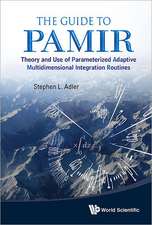Functions of One Complex Variable I
Autor John B. Conwayen Limba Engleză Hardback – 24 aug 1978
| Toate formatele și edițiile | Preț | Express |
|---|---|---|
| Paperback (1) | 456.98 lei 6-8 săpt. | |
| Springer – 14 ian 1994 | 456.98 lei 6-8 săpt. | |
| Hardback (1) | 337.45 lei 3-5 săpt. | +33.14 lei 7-13 zile |
| Springer – 24 aug 1978 | 337.45 lei 3-5 săpt. | +33.14 lei 7-13 zile |
Preț: 337.45 lei
Nou
Puncte Express: 506
Preț estimativ în valută:
64.58€ • 67.01$ • 53.98£
64.58€ • 67.01$ • 53.98£
Carte disponibilă
Livrare economică 22 februarie-08 martie
Livrare express 08-14 februarie pentru 43.13 lei
Preluare comenzi: 021 569.72.76
Specificații
ISBN-13: 9780387903286
ISBN-10: 0387903283
Pagini: 322
Ilustrații: XIV, 322 p.
Dimensiuni: 156 x 234 x 28 mm
Greutate: 0.64 kg
Ediția:2nd ed. 1978
Editura: Springer
Colecția Springer
Locul publicării:New York, NY, United States
ISBN-10: 0387903283
Pagini: 322
Ilustrații: XIV, 322 p.
Dimensiuni: 156 x 234 x 28 mm
Greutate: 0.64 kg
Ediția:2nd ed. 1978
Editura: Springer
Colecția Springer
Locul publicării:New York, NY, United States
Public țintă
GraduateCuprins
I. The Complex Number System.- §1. The real numbers.- §2. The field of complex numbers.- §3. The complex plane.- §4. Polar representation and roots of complex numbers.- §5. Lines and half planes in the complex plane.- §6. The extended plane and its spherical representation.- II. Metric Spaces and the Topology of ?.- §1. Definition and examples of metric spaces.- §2. Connectedness.- §3. Sequences and completeness.- §4. Compactness.- §5. Continuity.- §6. Uniform convergence.- III. Elementary Properties and Examples of Analytic Functions.- §1. Power series.- §2. Analytic functions.- §3. Analytic functions as mapping, Möbius transformations.- IV. Complex Integration.- §1. Riemann-Stieltjes integrals.- §2. Power series representation of analytic functions.- §3. Zeros of an analytic function.- §4. The index of a closed curve.- §5. Cauchy’s Theorem and Integral Formula.- §6. The homotopic version of Cauchy’s Theorem and simple connectivity.- §7. Counting zeros; the Open Mapping Theorem.- §8. Goursat’s Theorem.- V. Singularities.- §1. Classification of singularities.- §2. Residues.- §3. The Argument Principle.- VI. The Maximum Modulus Theorem.- §1. The Maximum Principle.- §2. Schwarz’s Lemma.- §3. Convex functions and Hadamard’s Three Circles Theorem.- §4. Phragm>én-Lindel>üf Theorem.- VII. Compactness and Convergence in ihe Space of Analytic Functions.- §1. The space of continuous functions C(G, ?).- §2. Spaccs of analytic functions.- §3. Spaccs of meromorphic functions.- §4. The Riemann Mapping Theorem.- §5. Weierstrass Factorization Theorem.- §6. Factorization of the sine function.- $7. The gamma function.- §8. The Riemann zeta function.- VIII. Runge’s Theorem.- §1. Runge’s Theorem.- §2. Simple connectedness.- §3.Mittag-Leffler’s Theorem.- IX. Analytic Continuation and Riemann Surfaces.- §1. Schwarz Reflection Principle.- $2. Analytic Continuation Along A Path.- §3. Monodromy Theorem.- §4. Topological Spaces and Neighborhood Systems.- $5. The Sheaf of Germs of Analytic Functions on an Open Set.- $6. Analytic Manifolds.- §7. Covering spaccs.- X. Harmonic Functions.- §1. Basic Properties of harmonic functions.- §2. Harmonic functions on a disk.- §3. Subharmonic and superharmonic functions.- §4. The Dirichlet Problem.- §5. Green’s Functions.- XI. Entire Functions.- §1. Jensen’s Formula.- §2. The genus and order of an entire function.- §3. Hadamard Factorization Theorem.- XII. The Range of an Analytic Function.- §1. Bloch’s Theorem.- §2. The Little Picard Theorem.- §3. Schottky’s Theorem.- §4. The Great Picard Theorem.- Appendix A: Calculus for Complex Valued Functions on an Interval.- Appendix B: Suggestions for Further Study and Bibliographical Notes.- References.- List of Symbols.
Recenzii
"This book presents a basic introduction to complex analysis in both an interesting and a rigorous manner. It contains enough material for a full year's course, and the choice of material treated is reasonably standard and should be satisfactory for most first courses in complex analysis. The approach to each topic appears to be carefully thought out both as to mathematical treatment and pedagogical presentation, and the end result is a very satisfactory book for classroom use or self-study." --MathSciNet























